I am interested by the Ripole design of subwoofer. Somewhat reminiscent of an AMT but for bass in a arrangement that would seem to benefit form force cancellation between the two drivers. This interests me because the macbook pro has extremely good bass for it;s size and reportedly also uses force cancellation (and a whole lot of DSP i suspect too)
So my question.. is it possible to make a really small ripole and have it function as well relative to it's size as the MBP does? the only examples i have seen use 12"+ drivers. is there a reason for that? if i were to build one with 5 or 6" drivers would it work at all? Are there any design tools available?
So my question.. is it possible to make a really small ripole and have it function as well relative to it's size as the MBP does? the only examples i have seen use 12"+ drivers. is there a reason for that? if i were to build one with 5 or 6" drivers would it work at all? Are there any design tools available?
You can (just about) simulate with Hornresp. Being a dipole system, there's a lot of loss to overcome, which is why most implementations use large drivers.
Modern phones and high-end laptops sound great for the size of the thing. The laptops seem to use dual drivers in sealed boxes, with a force-cancelling arrangement. That way, they can crank up the power input without vibrating/rattling the laptop to pieces.
Chris
Modern phones and high-end laptops sound great for the size of the thing. The laptops seem to use dual drivers in sealed boxes, with a force-cancelling arrangement. That way, they can crank up the power input without vibrating/rattling the laptop to pieces.
Chris
So my question.. is it possible to make a really small ripole and have it function as well relative to it's size as the MBP does? the only examples i have seen use 12"+ drivers. is there a reason for that? if i were to build one with 5 or 6" drivers would it work at all? Are there any design tools available?
Yes, it is possible - here are my personal design and experimentations :
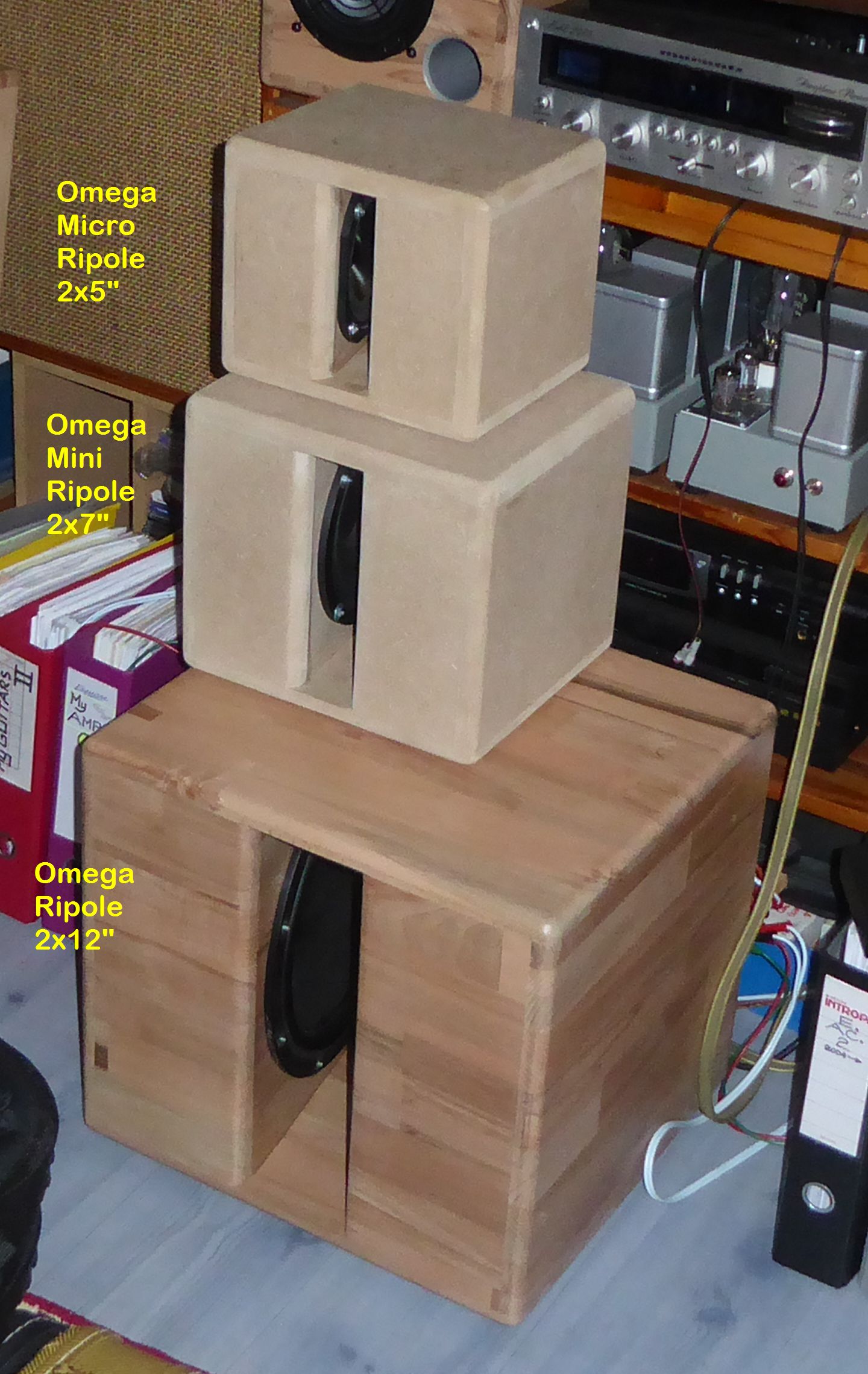
Here's the most compact : the Micro-Ripole...

I'd say that the problem for me was to find a "serious" super-compact subwoofer module, and I find none with a valuable LPF really adjustable in FC and Slope...
The one that I used had unefficient LPF that completely ruined the performance of my small 2x5" and 2x7" Omega Ripoles :
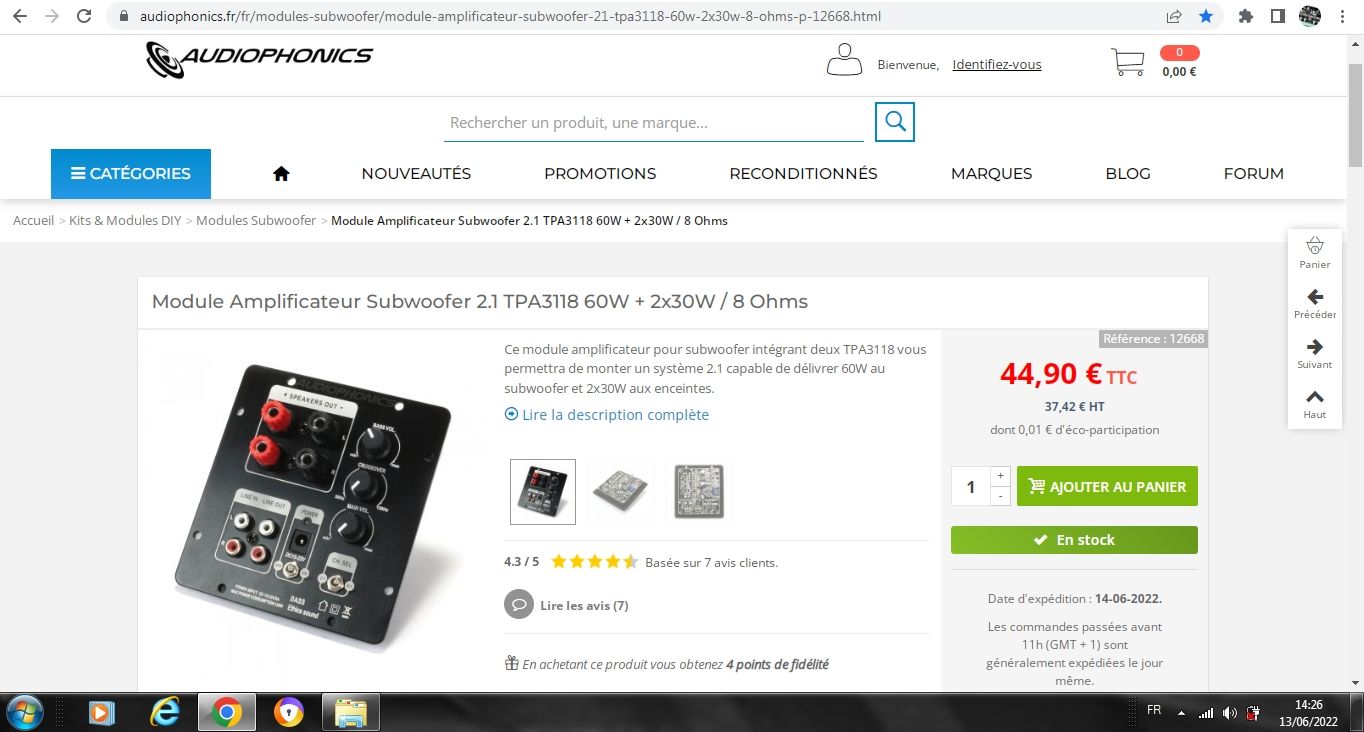
This is a pity, because while connected to the "serious" ATOHM S250 sub module that I use on my Omega Ripole 2x12", the 5" and 7" models worked amazingly...
Below my 2x12 version, able to reach 15Hz (low resonant frequency measured). I usually set the LPF module at 40Hz / 12dB/Oct. or 24dB/Oct. , just to operate under the natural lowcut of the loudspeakers associated with. For example, with my Magnepan SMGb, 40Hz / 12dB/Oct. is fine, just for providing that deep, floating infra-bass extension that notably exist in Space Ambient EM...

The 2x5" showed an extension to 25Hz (FS), which is a performance for such a compact subwoofer :
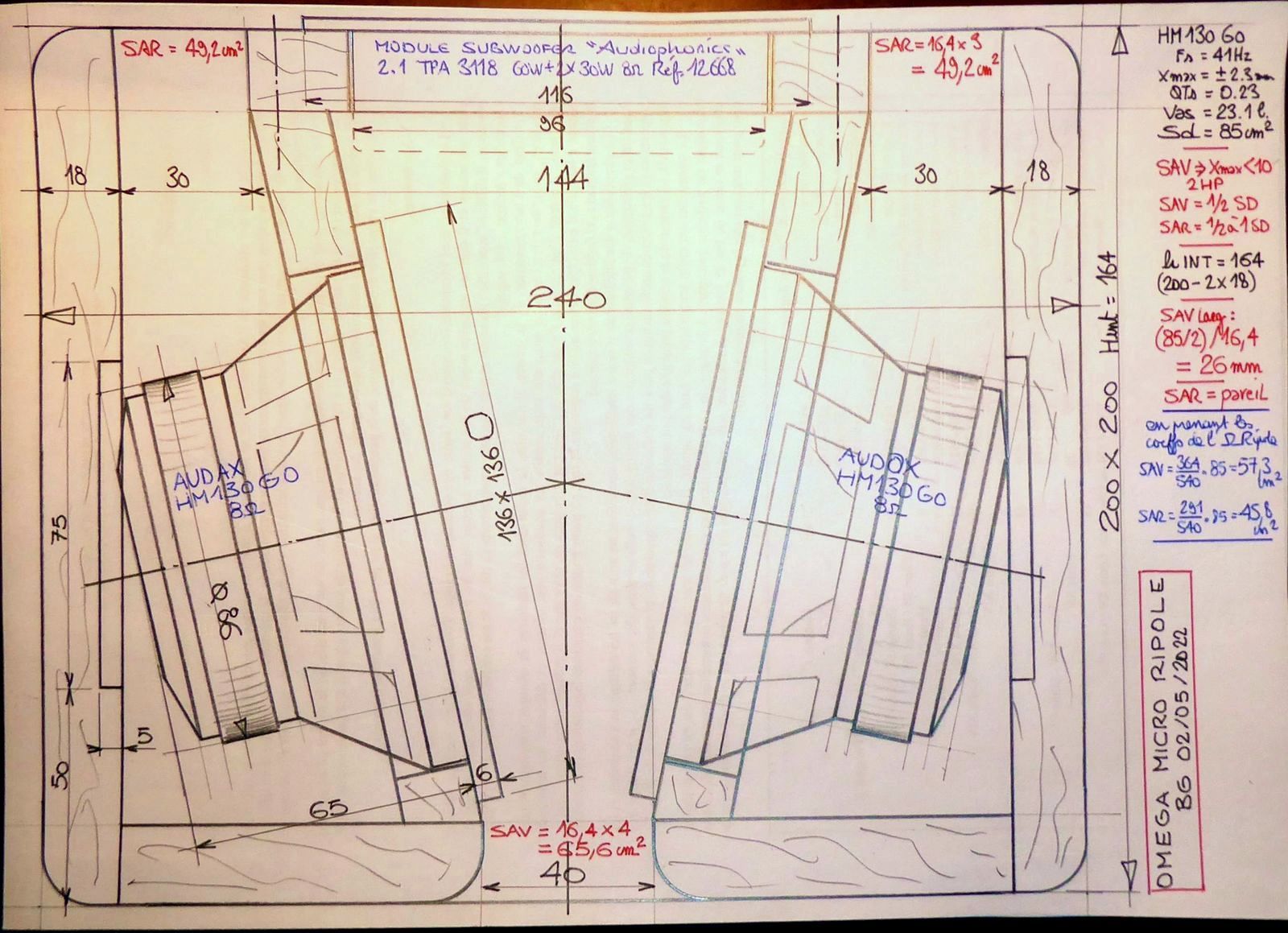
That said, even with a competent sub module + performant LPF, don't expect to reproduce HT earthquakes with such a small unit !
The infra-bass extension in compact size has a price to pay, and concerning the Ripole principle, it's reduced efficiency (usually 6 to 10dB/W/m under the nominal efficiency of the speaker), and that's the main reason why the Ripoles are often built with 12", 15" or 18" speakers, in order to combine super low extension with power handling and efficiency...
T
Last edited:
@tubelectron thanks for your photos! Could you expand a little more on your experiences or opinion on your ripole builds? Compared to any other subwoofers/dipole speakers, did they have the same "clarity" or lightness that is often associated with dipoles and ripoles?
If I understand correctly you used the plate amp's control to increase the bass, right? Would you know approximately how many db of gain you likely ended up with? Assuming your 5" driver is the Audax HM130G0, that appears to have a sensitivity in the 70s in the bass, so it sounds like it got quite a nice boost.
Regarding the drivers, could you mention which which were the other drivers used? I remember the TangBand "micro subwoofer" drivers having apparently 10mm one-way xmax, but they also end up charging $100 for a 3" driver
I think the dayton audio ND or Epique drivers may be good candidates purely from an excursion point of view, though there's also the SB Acoustics SB15SFCR39 with a nice/unusual 5"*8" driver for a bit over $40. It's got 5mm xmax (1way) too, similar to the ND range. (The audax appears to only have 2.3mm apparently). And unlike the 5.25" ND driver (which feels barely different from the 4"), the SB has an Fs of 31hz (and 80+db sensitivity above 25hz).
Ps the woodworking and curves look really well done!
If I understand correctly you used the plate amp's control to increase the bass, right? Would you know approximately how many db of gain you likely ended up with? Assuming your 5" driver is the Audax HM130G0, that appears to have a sensitivity in the 70s in the bass, so it sounds like it got quite a nice boost.
Regarding the drivers, could you mention which which were the other drivers used? I remember the TangBand "micro subwoofer" drivers having apparently 10mm one-way xmax, but they also end up charging $100 for a 3" driver
I think the dayton audio ND or Epique drivers may be good candidates purely from an excursion point of view, though there's also the SB Acoustics SB15SFCR39 with a nice/unusual 5"*8" driver for a bit over $40. It's got 5mm xmax (1way) too, similar to the ND range. (The audax appears to only have 2.3mm apparently). And unlike the 5.25" ND driver (which feels barely different from the 4"), the SB has an Fs of 31hz (and 80+db sensitivity above 25hz).
Ps the woodworking and curves look really well done!
There's no real enclosure for WinISD to model, and the response doesn't much matter because you'll be EQing it regardless.@AllenB No, i was meaning CAD tools like WinISD for ripole 'enclosures'
Apart from T/S, that leaves the polar behaviour to model.
@tubelectron thanks for your photos! Could you expand a little more on your experiences or opinion on your ripole builds? Compared to any other subwoofers/dipole speakers, did they have the same "clarity" or lightness that is often associated with dipoles and ripoles?
If I understand correctly you used the plate amp's control to increase the bass, right? Would you know approximately how many db of gain you likely ended up with? Assuming your 5" driver is the Audax HM130G0, that appears to have a sensitivity in the 70s in the bass, so it sounds like it got quite a nice boost.
Regarding the drivers, could you mention which which were the other drivers used? I remember the TangBand "micro subwoofer" drivers having apparently 10mm one-way xmax, but they also end up charging $100 for a 3" driver
I think the dayton audio ND or Epique drivers may be good candidates purely from an excursion point of view, though there's also the SB Acoustics SB15SFCR39 with a nice/unusual 5"*8" driver for a bit over $40. It's got 5mm xmax (1way) too, similar to the ND range. (The audax appears to only have 2.3mm apparently). And unlike the 5.25" ND driver (which feels barely different from the 4"), the SB has an Fs of 31hz (and 80+db sensitivity above 25hz).
Ps the woodworking and curves look really well done!
You welcome @Abhishmuk !
When I wanted to add a subwoofer to my audio system, it had to comply with several key points :
- maximum bass extension to reach infra-bass range.
- compactness, because of my small auditorium - fortunately without notable tone flaw - where I listen in near field, de facto...
- no boxy-boomy sound.
- swift transient and excellent damping.
All this for a price I accepted to pay : a moderate efficiency and power handling - compared to the usual Home-Theater-Thunder-Earthquake-Crash use and models - because most of the time I listen at low to moderate levels... Music !
Below, you can see my Omega Ripole 2x12" centered between the speakers :
I first borrowed to my Audio friends some Bass-Reflex and ASW subwoofers from different brands : Klipsch, Celestion, Magnat... To have an idea about what to hear. All of them worked OK, adding bass level as expected, but it was not so deep and infra-bass extended without having to endure some boomy-boxy sound... Which was not so pleasant to my ears. I had the impression that it was the price to pay...
Then after reading the litterature on the Ripole subject, from Axel Ridtahler (the father of the Ripole principle) and several web pages, notably this one :
http://jazzman-esl-page.blogspot.com/2011/01/ripole-subs-are-underway.html
I decided to venture in, and the result was my Omega Ripole 2x12", a personal variant of the Ripole principle, in order to integrate the subwoofer module in the cabinet. Immediately, the results were convincing - I knew where to wait, as I had several subs for tests...
The most obvious - not to say amazing for the size of the unit - compared to the other subs I tested, is that impression of deep, floating infra-bass, without that boxy-boomy sound masking the low-end range, plus a fast transient response (attack / decay) and clarity allowing to hear the note's sound imprint, level and separation.
According to Mr Ridtahler, the coverage pattern of the Ripole is some kind of assymetric 8 : the larger lobe being at the front, with a spread angle at circa 90° (+/-45° from axis), the smaller being at the back, just to balance the directivity of the front.
This present the advantage - still according to Axel Ridtahler - of absence of room excitation on the lateral sides (180°, +/-90° from axis) by reduction of the bass amplitude in these areas, an useful point for placing turntables and electronics, which will be "substracted" from the infra-bass influence.
I think this answers to your first question concerning the tone of a Ripole...
About the level and setup of the subwoofer module :
Consider that usually, a Ripole shows an efficiency at circa 6 to 10dB under the nominal efficiency of the speaker. It depends on the number of speakers (one, two, or several), and on the size of the front and back openings.
With only one speaker, small cabinet and small openings, you have a lower infra-bass extension, but indeed closer to a -10dB attenuation. Conversely, with two speakers and matching openings, you are circa a -6dB attenuation. This will be compensated by the gain control and available power of the subwoofer module - assuming it has a convenient performance LPF, of course.
For example, here is the setup I use on my Omega Ripole 2x12" with my Magnepan SMGb driven by my McIntosh MC7100 :
But this compensation has a limit : the power handling of the speaker(s) and - most of all - the Xmax and Xdamage. The Beyma 12BR70 that I use in my Omega Ripole 2x12" offer a 94dB/W/m, a Xmax at +/-8mm, and a FS at 28Hz and 29Hz respectively (measured), with a QTS at 0.5.
With such arrangement, and in a 400x400x440mm format, I reach a 15Hz low extension, with circa 88dB/W/m, which is way enough for me : at 20WRMS in the 0-40Hz range delivered by the module to the spakers, the sub already reach 101dB/W/m... But OK : for Home Theater of huge systems, this may be not enough !
A friend of mine, after being seduced by my 2x12" Omega Ripole's qualities, decided to go bigger - in accordance with his large, hi-efficiency, multi-amplified system : two 2x18" Ripoles (below, at L and R, unfinished plywood) powered by an external stereo 2x1kw amp, plus sub active filter... He promplty sold his two Velodyne subs :
About the drivers to use : these must have a generous Xmax (again : if you want high output) and a QTS which is not to low. Typically, speakers for sealed enclosures are convenient (QTS = 0.5 to 0.7), plus a low FS. Possibly, speakers for open baffles can be convenient too (some SB Audience Bianco models in 12, 15 and 18", notably).
The drivers that I used are the BEYMA 12BR70 (trusted reliability units for years), Monacor SPH-170 (7") and Audax HM130G0 (5"). My pal used SB Audience Bianco 18SW450-8 on his 2x18 Ripoles.
A member of the DIYaudioproject forum followed my plans of 2x5" Omega Micro subwoofer, building it by 3D printing. Here's the link :
https://diyaudioprojects.com/Forum/viewtopic.php?f=11&t=7327
I have no experience about the speakers you mention, but for sure : do not choose them too small (5" minimum) as the final dimension of the cab is compact by construction...
Yes, the SB Acoustics SB15SFCR39 with its 5"x8" oval dimension / FS=31Hz / Xmax=+/-7mm / N=87dB/W/m / QTS=0.42 should be a good candidate for a Ripole test, at 48€ here in France.
https://www.toutlehautparleur.com/h...sb15sfcr39-8-impedance-8-ohm-5-x-8-pouce.html
Good Luck !
T
Last edited:
macbook pro has extremely good bass for it;s size and reportedly also uses force cancellation (and a whole lot of DSP i suspect too)
And bi-amped. Most Macs now have WAWs with force cancelation woofer assemblies.
Still too new for one to come by so i can take it apart. I do have A LOT of speakers out of Macs. Interestin g to see the progress.
dave
Most Macs now have WAWs
Just had breakfast. Have an earlier single woofer + midTweeter version out of an iMac.
dave
Good Luck !
T
Tubelectron,
Could you share some acoustic measurements of your ripole subwoofer(s)?
88dB@15Hz@1w is an exceptional result for such a compact design. Is that outdoors, or in-room?
Chris
Let's be honest @chris661 : unfortunately, I did not made any true acoustical measurements to check it , but I should ! 
My measurement equipment is obsolete (thank you Windows) and I am still lazy to set up my new one (which sleeps in carton and on HDD). I know : it's a shame...
I took the following reasoning :
These are reasonable assumptions, I think - but nonetheless assumptions - that's true.
That said, the bandwidth is in my case limited to 40Hz by the LPF of the sub module, and the dB level of the Ripole can be set up accordingly to fill the lack of infra-bass of the regular loudspeaker, that occurs under its natural bass cutoff frequency. Thus, the limit in dB output of the Ripole is rather due to the Xmax acceptance and power handling of the chosen speakers in the infra-bass range...
Below, a document due to A. Ridtahler, showing at right the typical bass extension response of Ripole subwoofer :
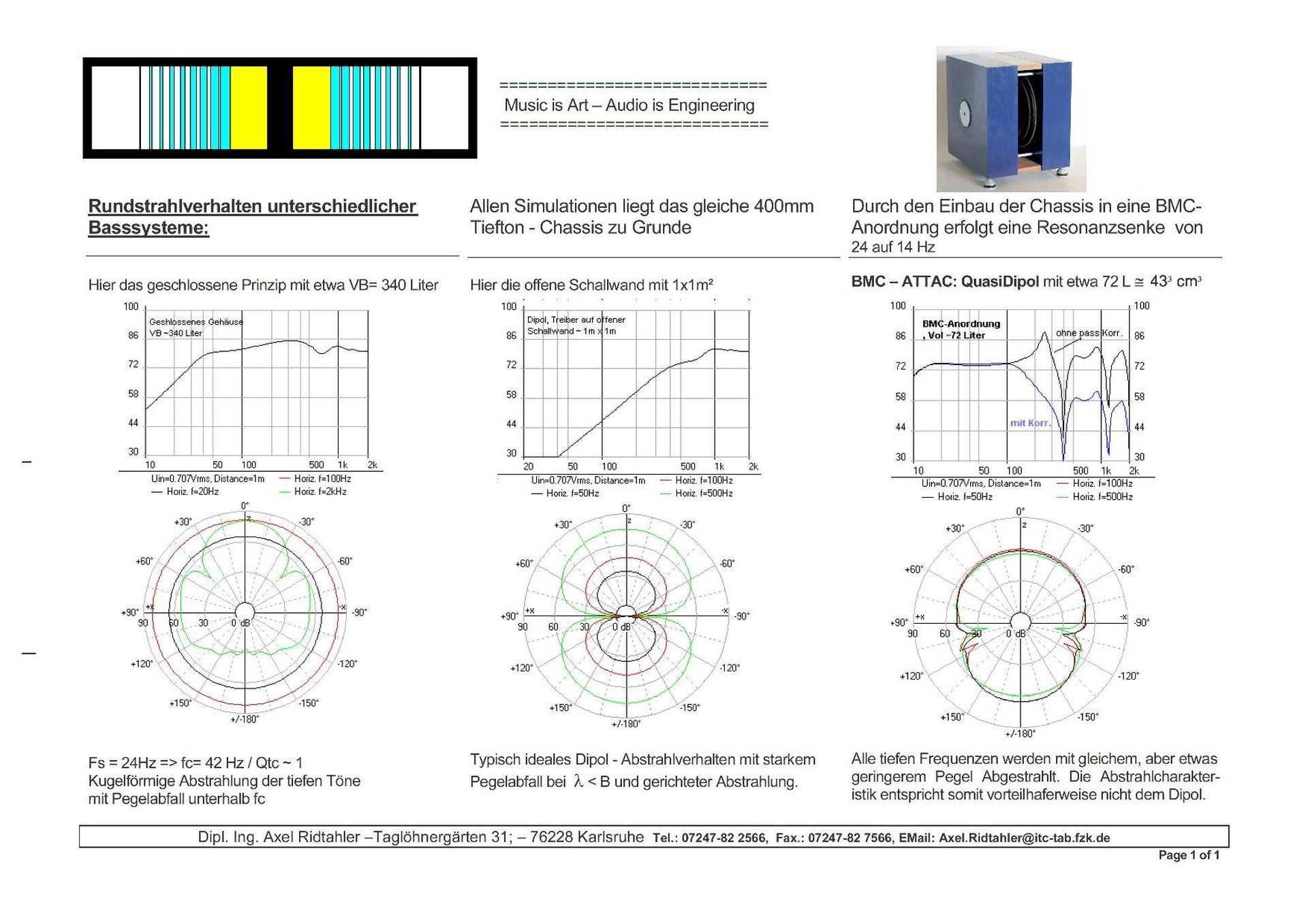
T
My measurement equipment is obsolete (thank you Windows) and I am still lazy to set up my new one (which sleeps in carton and on HDD). I know : it's a shame...
I took the following reasoning :
- The efficiency of a single 12BR70 is 93.5dB/W/m.
- Here I use two of them, so it's a +6dB increase in level.
- The Ripole principle is reputedly lowering the nominal efficiency of one speaker about 10dB (according to Mr Ridtahler and many users), so the result should be optimistically circa 93.5+6-10=89.5dB/W/m.
- I consider that it could be circa 88dB/W/m at the measured FS of 15Hz - which is the measured FS value by myself on my omega Ripole - given that, usually in the Ripole principle, the bass extension is preserved in level until the measured FS of the system.
These are reasonable assumptions, I think - but nonetheless assumptions - that's true.
That said, the bandwidth is in my case limited to 40Hz by the LPF of the sub module, and the dB level of the Ripole can be set up accordingly to fill the lack of infra-bass of the regular loudspeaker, that occurs under its natural bass cutoff frequency. Thus, the limit in dB output of the Ripole is rather due to the Xmax acceptance and power handling of the chosen speakers in the infra-bass range...
Below, a document due to A. Ridtahler, showing at right the typical bass extension response of Ripole subwoofer :

T
Last edited:
How well would these work with a 1/4 wave pipe like the Frugal horns? Would the back wave of the Ripole cancel the output of the pipe where the responses overlap?
Interesting question. I think that member @planet10, which extensively worked on the Frugal Horn design, can give us a clue...
What I can tell is that the Ripole principle works / marry better with Dipole patterns, like offered by Magnepan speakers, compared to the usual subwoofer ported systems. Below, tests performed at the home's Audio friend - a Magnepan afficonado :
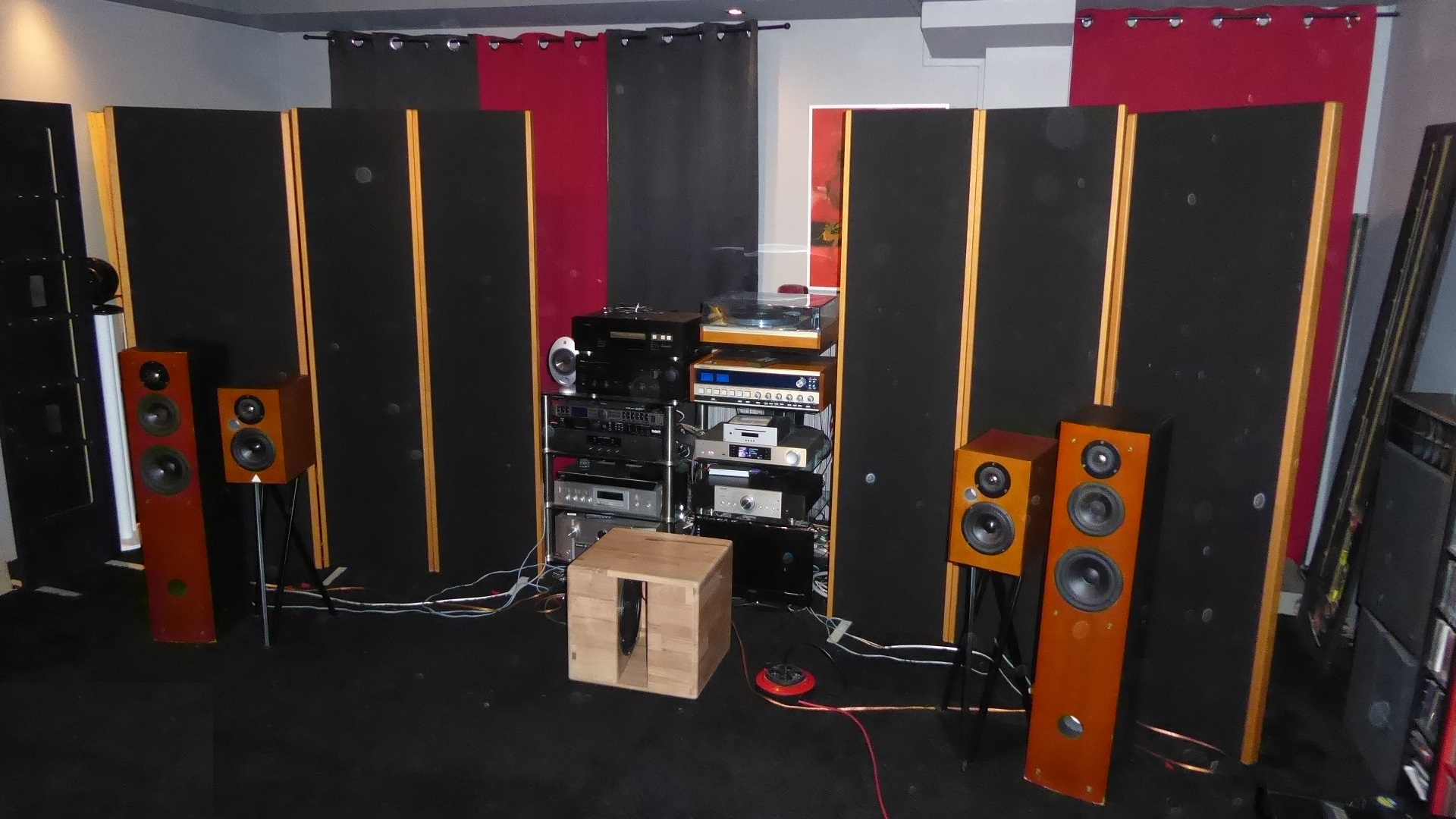
T
Frugel-Horn is a horn, a mono-pole radator with bass gain.
Ripola is an OB.
Could get complicated.
dave
Today, I went at one of my Audio friend's house to experiment my Omega Ripole with his DIY horns, to see if the Ripole could do his job of bringing the infra-bass complement...
We tested two positions :
N°1 - In the plan of the two horns, unfortunately not centered, due to furniture position :
N°2 - Then more advanced in the room :
As pointed by @planet10 : more critical to marry with horns... At least, more difficult to place than with a pair of Magnepan speakers (SMGb, MG2.5, MG3.5, etc...), which are dipole speakers.
The better position was the N°2, advanced close to the center of the room, to achieve that floating infra-bass tone filling gently the room. We even had the impression that the extra-bass was provided by the horns themselves, possibly due to the position of the Ripole, its radiation pattern, and the size / geometry of the room...
My friend find that it was an interesting addition to his horns for the image and the ambience, but a 2x15" version would be a safer plus, due to the large size of the room.
Verdict : yes, it works with horns, but it is more touchy to set up than with dipole speakers (Electrostatics, Magneplanars, Open Baffle).
T
Thanks a lot for the detailed write-ups @tubelectron!
When you tried your ripole with your friend's horns does that mean you put the ripole's outputs where the horn's driver would sit? If not, it might be interesting to consider that - it would need 2x the number of horns as you'd need one for every side of the driver, but I'd expect some good output, though at the cost of space/size.
When you tried your ripole with your friend's horns does that mean you put the ripole's outputs where the horn's driver would sit? If not, it might be interesting to consider that - it would need 2x the number of horns as you'd need one for every side of the driver, but I'd expect some good output, though at the cost of space/size.
Wow, those horns are beautiful! As a cabinetmaker myself, I can appreciate the considerable skill that goes into such joinery. Well done!Today, I went at one of my Audio friend's house to experiment my Omega Ripole with his DIY horns, to see if the Ripole could do his job of bringing the infra-bass complement...
View attachment 1304487 View attachment 1304488 View attachment 1304489 View attachment 1304490
We tested two positions :
N°1 - In the plan of the two horns, unfortunately not centered, due to furniture position :
View attachment 1304491
N°2 - Then more advanced in the room :
View attachment 1304493
As pointed by @planet10 : more critical to marry with horns... At least, more difficult to place than with a pair of Magnepan speakers (SMGb, MG2.5, MG3.5, etc...), which are dipole speakers.
View attachment 1304509
The better position was the N°2, advanced close to the center of the room, to achieve that floating infra-bass tone filling gently the room. We even had the impression that the extra-bass was provided by the horns themselves, possibly due to the position of the Ripole, its radiation pattern, and the size / geometry of the room...
My friend find that it was an interesting addition to his horns for the image and the ambience, but a 2x15" version would be a safer plus, due to the large size of the room.
Verdict : yes, it works with horns, but it is more touchy to set up than with dipole speakers (Electrostatics, Magneplanars, Open Baffle).
T
Your impression that the added bass seemed to come from the horns themselves is proof of a successful integration. Perhaps some phase delay might've rectified the placement problem? What crossover/slope was used?
Ah, thanks for the correction. I'm not sure what the difference between a Voigt pipe and a Frugal horn is. On the surface they're quite similar.Frugel-Horn is a horn.
dave
- Home
- Loudspeakers
- Subwoofers
- Really tiny RiPole